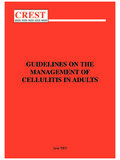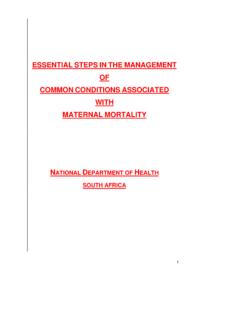Transcription of MALIGNANT CATARRHAL FEVER
1 1 MALIGNANT CATARRHAL FEVER Aetiology Epidemiology diagnosis Prevention and Control References AETIOLOGY Classification of the causative agent Virus family Herpesviridae, subfamily Gammaherpesvirinae, genus Macavirus. The MCF subgroup of viruses, called MCFV, contains at least 10 members, five of which are currently known to cause disease. Wildebeest-associated MCF: alcelaphine herpes virus 1 (AlHV-1). Endemic in wildebeest populations worldwide. Sheep-associated MCF: ovine herpesvirus 2 (OvHV-2). Endemic in most sheep populations worldwide. Caprine-associated MCF: caprine herpesvirus 2 (CpHV-2): Endemic in most domesticated goat populations worldwide, and causes MCF in cervids. Unknown origin: causes MCF in white-tailed deer (MCFV-WTD). Roan antelope origin: Hippotragine herpesvirus-1 was used to experimentally induce MCF in rabbits Resistance to physical and chemical action Temperature: No data available, but virus is very labile.
2 PH: Mostly stable between pH Disinfectants/chemicals: Inactivated by common disinfectants including sodium hypochlorite (3% solution if heavy organic debris present) Survival: Inactivated rapidly by sunlight. Cell-associated virus survives 72 hours outside the host; cell-free virus is inactivated quickly in dry environments but may survive over 13 days in humid environments EPIDEMIOLOGY MCF is a generally fatal disease of cattle and many other species of Artiodactyla, which occurs following infection with certain herpesviruses of the genus Macavirus. Five herpesviruses have been recognised as causing MCF, the best characterised being AIHV-1 and OvHV-2. MCF usually appears sporadically and affects few animals, though both AlHV-1 and OvHV-2 can give rise to epizootics.
3 The disease has been most often described as affecting species of the subfamily Bovinae and family Cervidae, but is also recognised in domestic pigs, giraffe and species of antelope belonging to the subfamily Tragelaphinae. Animals that develop MCF are usually dead end hosts. AlHV-1: Transmission in wildebeest occurs perinatally; all calves become infected within the first few months of life and remain carriers for life Transmission to susceptible hosts occurs only from wildebeest; there is no definitive evidence that MCF-affected animals transmit the disease horizontally to others Most cases of wildebeest-associated MCF occur when susceptible animals are exposed to parturient wildebeest or young calves, or pasture contaminated by them.
4 OvHV-2: A proportion of lambs are infected in utero with most lambs becoming infected perinatally Transmission is only from sheep to susceptible hosts, not horizontally between infected hosts 2 Hosts Carrier species with inapparent infections include wildebeest, sheep, and goats Clinical infections occur in members of the families Bovidae; Cervidae, and Giraffidae, such as cattle, water buffalo, bison, deer, and other wild ruminants Deer species affected: red deer, axis deer, fallow deer, Formosan sika deer, mule deer, P re David s deer, Reeve s muntjac, swamp deer, white-tailed deer Other species affected: antelope, banteng, elk, reindeer, gaur, giraffe, greater kudu, nilgai and wapiti Domestic pigs in several countries have recently been confirmed as susceptible, and signs are very similar to those seen in acutely affected cattle Laboratory rabbits, Syrian hamsters, guinea-pigs and rats have been experimentally infected MCFV has been isolated from other exotic ruminants with unknown disease potential: ibex, musk ox, gemsbok, aoudads, hartebeest and topi.
5 Transmission AlHV-1 Transmission of AlHV-1 within free-living wildebeest populations is very efficient: all wildebeest calves are infected within the first few months of life by in utero, direct contact or aerosol routes. Contamination of pastures may also contribute to transmission, as may fomites Most transmission by wildebeest calves occurs at 1 2 months of age transmission after six months of age is rare Virus is shed by wildebeest calves in nasal and ocular secretions, mainly in the cell-free form Close contact is usually needed but transmission over one hundred metres has been reported Congenital transmission of AlHV-1 within infected domestic cows can occur with varying disease latency periods in newborn calves OvHV-2 Transmitted mainly by the respiratory route, probably in aerosols Shed intermittently in nasal secretions.
6 Particularly by 6 to 9 month old lambs A proportion of lambs are infected in utero with most lambs becoming infected perinatally, though infection may not occur in some situations till after 3 months of age. Close contact with sheep by susceptible species is usually required, but cases have been reported when sheep and cattle were separated by 70 metres, and in bison herds up to 5 km from a lamb feedlot There is a wide spectrum of susceptibility: Bos taurus and Bos indicus cattle are relatively resistant to OvHV-2 and cases are usually sporadic; most species of deer, bison (Bison bison) and water buffalo (Bubalus bubalis) are much more susceptible; and Bali cattle (Bos javanicus) and P re David s deer (Elaphurus davidianus) are extremely susceptible.
7 Sources of virus Nasal and ocular secretions mainly, but also reported in faeces and semen (OvHV-2 DNA detected in semen of domestic rams) Occurrence MCF viruses are found worldwide. AlHV-1- associated disease has been reported mainly in sub-Saharan Africa where cattle and wildebeest comingle, but can cause disease in zoological parks wherever carriers and susceptible species cohabitate. OvHV-2 - associated disease occurs throughout the world. For more recent, detailed information on the occurrence of this disease worldwide, see the OIE World Animal Health Information Database (WAHID) Interface 3 [ ] or refer to the latest issues of the World Animal Health and the OIE Bulletin. diagnosis Incubation period is variable, ranging from 11 34 days or up to 9 months Clinical diagnosis The clinical signs of MCF are highly variable and range from peracute to chronic.
8 In general, the most obvious signs develop in the more protracted cases. Peracute: either no clinical signs are detected, or depression followed by diarrhoea and dysentery may develop 12 24 hours prior to death In general: high FEVER , increased serous lachrymation and nasal exudate progressing to profuse mucopurulent discharge, inappetance, and decreased milk yields Progressive bilateral corneal opacity, starting at the periphery, is characteristic. Skin ulceration and necrosis may be extensive or restricted to the udder and teats Salivation and oral hyperaemia may be an early sign, progressing to erosions of the tongue, hard palate, gums and, characteristically, the tips of the buccal papillae Superficial lymph nodes may be enlarged and limb joints may be swollen Nervous signs such as hyperaesthesia, incoordination, nystagmus and head pressing may occur alone or with signs described above A few infected animals may recover following mild or even quite severe clinical reactions Lesions Gross pathological changes reflect the severity of clinical signs, but are generally widespread and may involve most organ systems.
9 Erosions and haemorrhages in gastrointestinal tract: contents may be haemorrhagic Enlarged lymph nodes, but degree varies within an animal CATARRHAL exudate, erosions and diphtheritic membranes often observed in the respiratory tract Urinary bladder often has characteristic ecchymotic haemorrhages of the epithelial lining, especially in bison Interstitial accumulation of lymphoid cells in nonlymphoid organs, in particular the renal cortex and periportal areas of the liver, is typical, and in the case of the kidney may be very extensive with development of multiple raised white foci, each 1-5 mm in diameter In the absence of molecular diagnosis , histologic changes are often relied on for diagnosis of MCF and are characteristic: epithelial degeneration, vasculitis, hyperplasia and necrosis of lymphoid organs, and widespread interstitial accumulations of lymphoid cells in nonlymphoid organs.
10 The brain may also show a nonsuppurative meningoencephalitis with lymphocytic perivascular cuffing and a marked increase in the cellularity of the cerebrospinal fluid Differential diagnosis Rinderpest Bovine viral diarrhoea mucosal disease Infectious bovine rhinotracheitis Bluetongue Epizootic haemorrhagic disease Foot and mouth disease Vesicular stomatitis Ingestion of caustic materials or some toxic plants 4 Laboratory diagnosis AIHV-1 may be recovered from clinically affected animals using peripheral blood leukocytes or lymphoid cell suspensions. Virus can also be recovered from wildebeest, either from peripheral blood leukocytes or from cell suspensions of other organs. OvHV-2 has never been identified formally, although lymphoblastoid cell lines propagated from affected animals contain OvHV-2-specific DNA and virus particles have been observed in these cells.


















